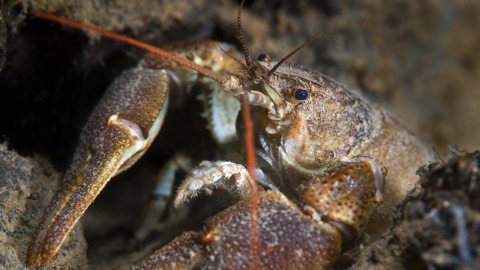
©Alex Mustard/2020VISION
White-clawed crayfish
Enw gwyddonol: Austropotamobius pallipes
The White-clawed crayfish is a freshwater, bronze-coloured crustacean with pale undersides to its claws - hence the name. It is under threat from an invasive and introduced species of crayfish.
Species information
Category
Ystadegau
Length: 6-12cmWeight: up to 90g
Average Lifespan: 8-12 years
Statws cadwraethol
Protected in the UK under the Wildlife and Countryside Act, 1981. Listed as Endangered on the global IUCN Red List of Threatened Species.
Pryd i'w gweld
January to DecemberYnghylch
As the UK's only native freshwater crayfish, the White-clawed crayfish is in decline due to the introduction of the non-native North American signal crayfish. This invasive species has brought disease to which our indigenous crayfish has no natural resistance. An omnivorous crustacean, the White-clawed crayfish eats invertebrates, carrion, water plants and dead organic matter. It inhabits small freshwater streams of a depth less than 1 metre, hiding underneath stones and rocks and in small crevices where they forage for food.Sut i'w hadnabod
The White-clawed crayfish is small and bronze-coloured, with pale cream or rose undersides on its claws.In our area
White-clawed Crayfish are now very rare and are only known from one river catchment in Montgomeryshire; the River Banwy and her tributaries. This population is clinging on in the face of imminent threats from Signal Crayfish and Crayfish Plague, so they need your help - Check, Clean, Dry
